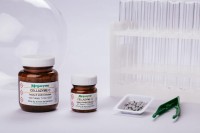
| Content: | 2.5 mL |
| Shipping Temperature: | Ambient |
| Storage Temperature: | 2-8oC |
| Formulation: | In 3.2 M ammonium sulphate |
| Physical Form: | Suspension |
| Stability: | Minimum 1 year at 4oC. Check vial for details. |
| Enzyme Activity: | Other Activities |
| Expression: | Purified from Trichoderma sp. |
| Unit Definition: |
exo-1,3-β-Glucanase: One Unit of exo-1,3-β-glucanase activity is defined as the amount of enzyme required to release one μmole of glucose reducing sugar equivalents per minute from laminarin (Laminaria digitata) (5 mg/mL) in sodium acetate buffer (100 mM) at pH 5.0 and 37oC. endo-1,3-β-Glucanase: One Unit of endo-1,3-β-glucanase activity is defined as the amount of enzyme required to release one μmole of glucose reducing sugar equivalents per minute from 1,3-Beta-Glucazyme HS Tablets (T-CUR-200T) in sodium acetate buffer (100 mM) at pH 5.0 and 37oC. |
| Temperature Optima: | 37oC |
| pH Optima: | 5 |
| Application examples: | Protoplast F is a lysing enzyme mixture used for generating protoplasts of Aspergillus niger. |
This product has been discontinued (read more).
Protoplast F is a lysing enzyme mixture containing cell wall degrading enzymes, e.g. exo-1,3-β-glucanase and endo-1,3-β-glucanase, and is used for generating protoplasts of Aspergillus niger.
The enzyme mixture is supplied as a precipitate in 3.2 M ammonium sulphate.
See more enzymes for analytical and research use.
Daly, P., Slaghek, G., López, S. C., Wiebenga, A., Hilden, K. S., de Vries, R. P. & Mäkelä, M. R. (2017). Journal of Microbiological Methods, 143, 38-43.
D. squalens, a white-rot fungus that efficiently degrades lignocellulose in nature, can be used in various biotechnological applications and has several strains with sequenced and annotated genomes. Here we present a method for the transformation of this basidiomycete fungus, using a recently introduced commercial ascomycete protoplasting enzyme cocktail, Protoplast F. In protoplasting of D. squalens mycelia, Protoplast F outperformed two other cocktails while releasing similar amounts of protoplasts to a third cocktail. The protoplasts released using Protoplast F had a regeneration rate of 12.5% (± 6 SE). Using Protoplast F, the D. squalens monokaryon CBS464.89 was conferred with resistance to the antibiotics hygromycin and G418 via polyethylene glycol mediated protoplast transformation with resistance cassettes expressing the hygromycin phosphotransferase (hph) and neomycin phosphotransferase (nptII) genes, respectively. The hph gene was expressed in D. squalens using heterologous promoters from genes encoding β-tubulin or glyceraldehyde 3-phosphate dehydrogenase. A Southern blot confirmed integration of a resistance cassette into the D. squalens genome. An average of six transformants (± 2 SE) were obtained when at least several million protoplasts were used (a transformation efficiency of 0.8 (± 0.3 SE) transformants per µg DNA). Transformation of D. squalens demonstrates the suitability of the Protoplast F cocktail for basidiomycete transformation and furthermore can facilitate understanding of basidiomycete gene function and development of improved strains for biotechnological applications.
Hide Abstract


















